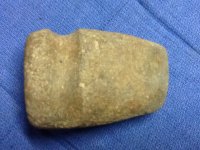Last summer after a major wash out, I was fishing a local stream.
In a bank on outside of a bend about a foot from the top I spied
what I thought to be a spear head. When I got up there and dug
it out it was this stone axe lying flat. I would have rather found
spear head but axe is better than nothing. Local experts tell me
that it is pre Indian, from Hopwell culture. We used to find arrow
heads in bottoms along this creek, no with no till farming they
are harder to come by.
In a bank on outside of a bend about a foot from the top I spied
what I thought to be a spear head. When I got up there and dug
it out it was this stone axe lying flat. I would have rather found
spear head but axe is better than nothing. Local experts tell me
that it is pre Indian, from Hopwell culture. We used to find arrow
heads in bottoms along this creek, no with no till farming they
are harder to come by.



